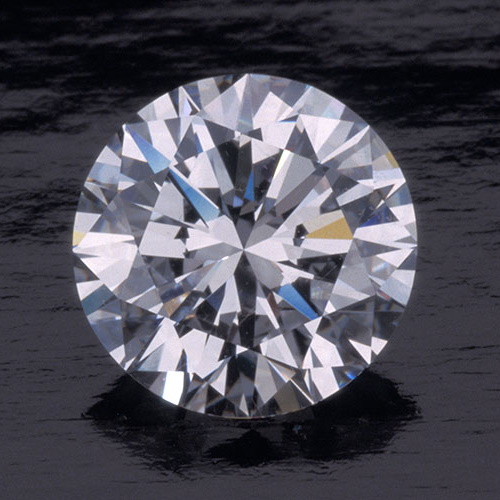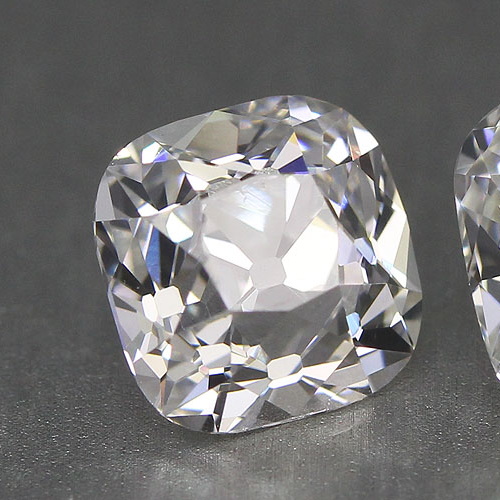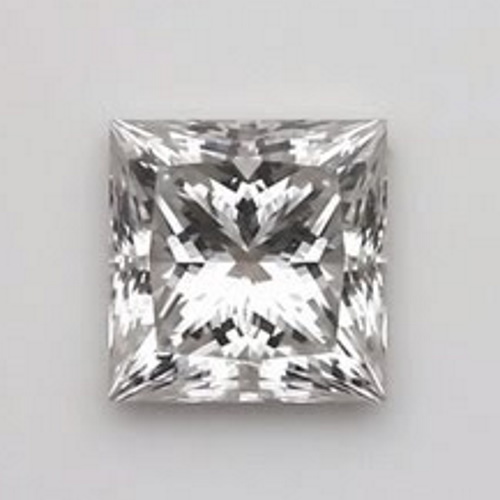Are the most popular and easily recognizable from all the diamond shapes. They are incredibly sparkly because of their intricate faceting and symmetrical shape.
CUT: The round brilliant diamond easily has the most sparkle and fire from ALL other shapes! The desirable aesthetic of round brilliants, along with the fact that it requires the most time and amount of rough diamond to produce, are a few reasons why round brilliants are also the most expensive of all diamond shapes. In addition, the faceting in round brilliants helps mask imperfections and increase the appearance of color (in a good way). There is no question that if you love the “bling” effect, the round brilliant is for you. Round brilliant diamonds are the most common shape for both jewelry and engagement rings. The versatility and brilliance of these diamonds makes them go well in most any setting!
QUALITY: Because they are great at hiding imperfections and color saturations, we would recommend a minimum of J color and SI2 clarity depending on the exact diamond and other factors.
To view quality and size comparisons from our loose diamond video gallery click here.
Fancy Shape Diamonds- refer to all diamond shapes other than round brilliant cut diamonds

CUSHION CUT diamonds offer a softer visual with a square and rectangular shape and rounded corners.
CUT: There are a few variations on the actual type of cushion cut. Most common cushions are called the Cushion Modified. These will exhibit what we call a “crushed ice” look where there are many small flashes of light giving off sparkle. There are true Cushion Brilliants which are rare and give off bright flashes of light with 8 main pavillion facets. The next type is a Cushion Hybrid and these have crisp clear faceting and bright sparkle with a larger than average face up size appearance. Keep in mind that diamonds listed as cushion modified on the GIA report can still exhibit the beauty and optical properties of a cushion brilliant should the pavilion facets be arranged properly.
QUALITY: Regular cushion cut diamonds with the crushed ice look will exhibit color more easily. For a regular Cushion Modified, opt for I color and above if you want it to look very white. Cushion brilliants and hybrids tend to hide color very well and a J color can have a nice white face up appearance. Depending on the types of inclusions, SI2 and above can be acceptable for cushions.
RATIO: Cushions tend to fall within the length to width ratios of 1:1 for a more square look, all the way to about 1:1.2 for a more rectangular/elongated look. We find the 1:1.1 ratio a popular range for elongated cushions. Generally an elongated cushion will look bigger on the hand because it takes up more length on the finger. To view quality and size comparisons from our loose diamond video gallery click here.

PRINCESS CUTS are typically square in shape with sharp corners. There are variations in terms of the chevrons, or central faceting, within each diamond. Some princess cuts have 2, 3, and 4 chevrons reaching the edge of the diamond. The less chevrons there are the more dispersed and spread out the sparkle the will be. See photo to the right. Save for the central faceting that looks like an X, count the number of subsequent chevrons on each image. The 4 chevrons look gives a very glittery effect because of so many tiny facets coming together for a very condensed brilliance. While the number of chevrons can be seen on the certificate and which one you prefer is definitely up to you.
QUALITY: Based on your color sensitivity, J color is a good starting place for a princess cut. SI2 and above depending on your diamond is a good option as well since they are quite good at hiding imperfections.
RATIO: Princess cut diamonds are supposed to be a perfect square, so the length to width ratio of a princess ideally will be about 1:1. While these are harder to find, there are some princess cuts with a more elongated look however the perfect square is a traditional princess cut and even up to 1.05:1 ratio. To view quality and size comparisons from our loose diamond video gallery click here.

EMERALD CUT is thought of as one of the most classic rectangular diamond shapes.
CUT: Emerald cuts are a step cut meaning their faceting is parallel. They have an open table that allows you to look clearly into the diamond.For these reasons, the emerald cut diamonds lack the fire and brilliance of other shapes. However, the elongated shape does allow for larger flashes of sparkle when rays of light reflect through them.Some think that because these diamonds have fewer facets than other fancy shapes making them have no sparkle whatsoever. This is not the case- when a well cut emerald diamond catches the light it will offer a beautiful flash of light.
QUALITY: Because of their open and clear faceting, we would recommend at least a VS2 in clarity, depending on the diamond. An eye clean SI may exist but would be extremely rare. Those that are color sensitive should opt for higher color however, to the naked eye J color and above work really well!
RATIO: Length to Width ratio is very important for emerald cuts because they vary so drastically and will give you dramatically different appearances. For emerald, ratios will typically vary from 1.0:1.30 for a more compact look all the way to 1.0:1.60 and above for a more elongated rectangular look for the emerald. To view quality and size comparisons from our loose diamond video gallery click here.

ASSCHER CUT diamonds were developed at the turn of the 20th century and are named after its creators, the Asscher brothers.
CUT: Diamond grading laboratories also refer to this diamond as a square emerald. The overall step cut faceting and shape are similar to the emerald cut, but has noticeably cut corners that make it resemble an octagon. The additional step facets create more sparkle and fire than its emerald cut counterpart.
QUALITY: In terms of quality, we would recommend J color and VS2 at the minimum for an asscher cut depending on the exact diamond! Asscher cuts are compact in shape and can show more color saturation so it is important to see what look would be most desirable to you.
RATIO: A traditional asscher cut is meant to look square, so the ratios will be 1:1 up to 1:1.1. A longer asscher will begin to appear like an emerald cut. To view quality and size comparisons from our loose diamond video gallery click here. Radiant cut diamonds, also referred to as square modified brilliants, diamonds were created with the purpose of introducing the brilliance that was lacking in square or rectangular shaped diamonds such as asscher and emerald cut.

RADIANT CUT diamonds, also referred to as square modified brilliants, diamonds were created with the purpose of introducing the brilliance that was lacking in square or rectangular shaped diamonds such as asscher and emerald cut. They are similar to the step cut in that these diamonds are often rectangular or square in shape with cropped or cut corners. However the radiant is faceted like a brilliant on both the crown and pavilion which makes it more brilliant. This criss-cross faceting, which is highly visible from a face up view, makes this diamond shape easily recognizable. It is a popular option for those who love the shape of the emerald or asscher cut diamonds but desire the brilliance and sparkle associated with the round.
QUALITY: Due to their facet pattern, radiant cuts are more forgiving to imperfections than its step cut counterparts. We would leave the minimum color at J and minimum clarity at SI2 only if the diamond is clean to the eye.
RATIO: For an elongated radiant cut diamond, an acceptable length to width ratio would be 1.15:1 all the way up to 1.40:1. For a square radiant cut your ratio is going to be in the range of 1:1 and a little above. To view quality and size comparisons from our loose diamond video gallery click here.

OVAL SHAPE diamonds are basically an elliptical adaptation of the round brilliant. Oval diamond prices are relatively high due to the limited supply available. Cut: Oval diamonds are brilliant cut giving a beautiful sparkle. Ovals will usually appear larger in size than a round cut of the same carat weight. This shape helps to elongate the finger and give a very graceful appearance on the hand.
RATIO: A more round and compact oval is going to have a Length to Width ratio in the 1:1.3 range whereas a more elongated oval is going to have a ratio above 1.4, closer to 1.5 ratio. The 1.4 ratio is a good middle ground, but by no means a strict number that you can’t deviate from.
QUALITY: Oval cuts can show color saturation quite easily. This is because ovals have a large surface area and they disperse color. Generally, we recommend I color and above. If someone is extremely particular, to stay even above that. Ovals are excellent at hiding imperfections, so we recommend that the diamond should be of SI2 clarity and above only if eye clean. To view quality and size comparisons from our loose diamond video gallery click here.

MARQUISE CUT diamonds can be described as being oval with pointed ends. Marquise shape are popular due to its slim, graceful appearance, highlighted by its pointed tips. Cut: This long and slender appearance assists in elongating the fingers of its wearer similar to the oval diamond. These diamonds also appear to be larger than their actual carat weight making them a great option for those looking for a distinguished alternative to the more common round and oval diamonds.
QUALITY: Marquise diamonds do not hide color so easily. As a general rule, I color and above is great. An eye clean SI2 clarity and above is perfectly acceptable for marquise cut diamonds. They are generally good at hiding imperfections as with the other shapes discussed in this post because it is a brilliant cut as well.
RATIO: The ideal length for a marquise-cut diamond is 1.75 to 2.25 of its width; generally, the stone should be about twice as longs as it is wide. As a general rule, we recommend getting a visual to see what marquise style appears the most appealing to you. To view quality and size comparisons from our loose diamond video gallery click here.

PEAR SHAPE diamonds also referred to as teardrops can be described as being a hybrid between an oval and marquise shape. Cut: Pear diamonds are brilliant cut giving a bright sparkle similar to oval and marquise. We do stress that the actual shape or outline of each pear diamond is extremely particular. No two pear shapes are ever cut exactly the same even if they weigh the same and that is why a real life visual (like videos we provide) is necessary to see the nuances.
QUALITY: Like oval and marquise, pear diamonds can show color easily. We recommend ‘I’ color and above to give you the whitest face up look. Pear shapes hide imperfections well, and we can safely recommend eye clean SI2 clarity diamonds and above for this shape
RATIO: Pear diamonds will have ratios between 1.4-1.7 generally. The 1.4 ratio will give a shorter and more rounded appearance with a 1.7 ratio being long and thinner. There are of course ratios in between so seeing what looks appealing to you is important. To view quality and size comparisons from our loose diamond video gallery click here.

HEART SHAPE CUT (shaped modified brilliant) is considered to be the most romantic of all shapes for obvious reasons. This fancy diamond is really a pear shape with a cleft at the top. Cut: Heart shapes are brilliant cut diamonds with a beautiful shine. These diamonds are naturally heavy set and must be cut with extreme accuracy to ensure maximum brilliance. More so than with other cuts, hearts shaped diamonds should always be seen in person to make sure the proportions and overall shape are well designed.
QUALITY: Similar to other brilliant cut diamond shapes, we tend to recommend J color and SI2 clarity as minimums. This would depend on your color sensitivity and the eye cleanliness of the diamond.
RATIO: There are a few variations in look, but if you want something more traditional then look for length-to-width ratios between .90 and 1.10. More so than with other cuts, hearts shaped diamonds should always be seen in person to make sure the proportions and overall shape are well designed. To view quality and size comparisons from our loose diamond video gallery click here.
